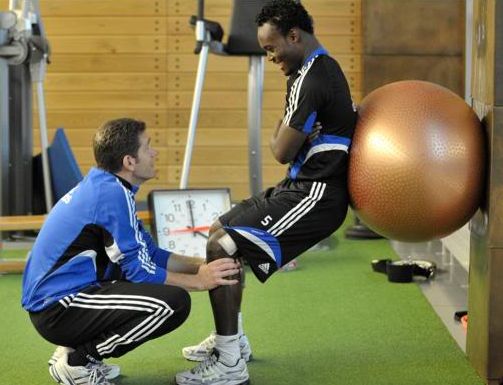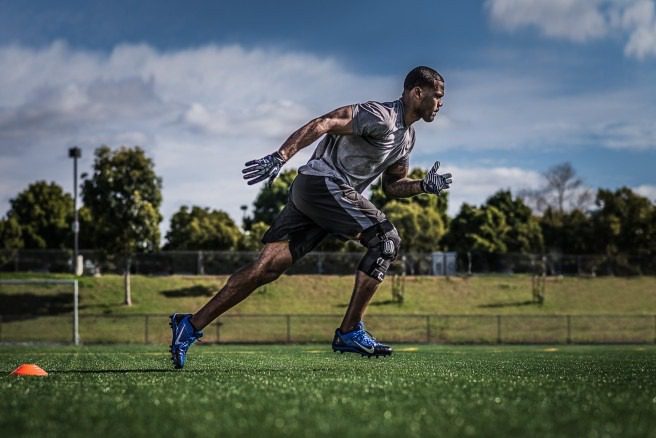Bridging The Gap: How to Return to Training Post ACL Reconstruction
RecoveryABOUT THE AUTHOR

Andrew Millett
Andrew Millett is a practicing physical therapist just outside of Boston, MA. His practice focuses on orthopedic and sports medicine. In addition to physical therapy, Andrew also has a background in strength and conditioning. This allows for Andrew to help bridge the gap between the physical therapy and the strength and conditioning realms. His practice includes blending a combination of treatment styles, specifically the Selective Functional Movement Assessment (SFMA), Functional Movement Screen (FMS), and the Y-Balance Test (YBT). Andrew has treated clients ranging form middle and high school and up to the Olympic ranks. More information can be found at www.andrewmillettpt.com. You can connect with Andrew through email: [email protected].
Anterior Cruciate Ligament (ACL) tears and reconstruction are very common in the world of athletics. Either you know of someone who has had their ACL reconstructed or you have yourself. (Prior to being a physical therapist, I had mine reconstructed TWICE!)
The risk for ACL tears and reconstructions is on the rise and some say it can be considered an epidemic. Women are 4-5x more likely to tear as men. ACL tears are not something that can be totally prevented, but with sound training, the incidence of them can be reduced.
As Mike Boyle has said, “ACL injury prevention is just good training.”
We can do all that we can to try and decrease the incidence of an ACL tear from happening to one of our athletes or clients. But, what if our athlete has already suffered an ACL injury? Where do we go from there?
First off, a licensed physical therapist will handle the immediate post-operative phases of the rehab process. This will include:
- Improving Range of Motion (ROM) – ideally hyperextension and full knee flexion
- Ensuring Proper Quadriceps Firing
- Decreasing Swelling
- Improving Core, Hip, Knee, and Ankle Stability
- Optimizing Single Leg Stance
Just because someone may be done with physical therapy and may have optimized the aforementioned areas does not mean they are ready to return to sport.
Many physical therapists are great at Stage I of the rehab process after an ACL reconstruction. But unless the PT has a background in strength and conditioning, this is typically where a gap is present.

More often than not in the physical therapy realm, patients or clients will be discharged from physical therapy at approximately 3 months after surgery. Whether it be due to insurance limitations or because the physical therapist believes this is as far as they can take the patient, and there is where you find that wide gap between the end of physical therapy and full return to sport.
I will typically take someone from the pre-operative phase of rehab to the post-operative phase… and then to the eventual return to sport.
// A Big Disclaimer
First off, if you are a strength and conditioning coach or personal trainer, contact the physical therapist!
Find out where the athlete left off in their rehab and what basic movement patterns they were performing (e.g. squat, hip hinge, etc.). This will give you a better idea of where to start the athlete and how to progress them.
An ACL reconstruction is a specific type of surgery, but there are different variations and specific post-operative restrictions when returning to strength and conditioning. Make sure you are part of the team and speak to the treating physical therapist to help guide your training program.
// The 3-Month Mark
At the 3-month mark, most athletes should be able to perform the basic fundamental movement patterns such as:
Find out where the athlete left off in their rehab and what basic movement patterns they were performing (e.g. squat, hip hinge, etc.). This will give you a better idea of where to start the athlete and how to progress them.
An ACL reconstruction is a specific type of surgery, but there are different variations and specific post-operative restrictions when returning to strength and conditioning. Make sure you are part of the team and speak to the treating physical therapist to help guide your training program.
This is where the strength and conditioning professional comes in.
If a client comes to you 3 months after surgery and they are done with physical therapy, where do you go from there?
Get them STRONG and ATHLETIC!
I would avoid testing athletes in their 1 to 3-RM until they are cleared to return to sport.
For frequency of training, 2-4x/week would be ideal to help improve the athlete’s strength and work capacity. Mind you, most athletes haven’t been on the field or court since their injury. They need to increase their work capacity in order to handle more stress on their body.
Regarding repetition schemes, bilateral compound movements such as squats, deadlifts, etc. should be trained between 3-6 reps. For rep schemes for single leg movements, repetitions can range from 6-12 reps.
Regarding progression and loading parameters, use typical progressive overload principles and progress the athlete as needed if movements are becoming too easy. As said before, avoid 1 to 3-rep max testing or movements where technical failure is likely.
Your Title Goes Here
Your content goes here. Edit or remove this text inline or in the module Content settings. You can also style every aspect of this content in the module Design settings and even apply custom CSS to this text in the module Advanced settings.
Kettlebell Deadlift
Trap Bar Deadlift
Goblet Squat
Rack Pulls
Reverse Lunge
Step-Ups
Lateral Lunges
// Core
Besides lower body strengthening, we want to make sure we are working on core strengthening as well. Stabilizing the core 360 degrees is ideal to make sure the athlete can stabilize their trunk and lower body.
Movements consisting of anti-extension, anti-lateral flexion, anti-flexion, and anti-rotation are key. Examples of these are:
Form and technique are of the utmost importance as with any training. If an athlete or client cannot maintain good technique, correct them. OR you can adjust the movement so they can be challenged, but their technique is on point.
// Mobility
Prior to commencing training, we want to make sure mobility is where it needs to be.
Strength is important, but so is mobility! We want to make sure the athlete is displaying sufficient mobility at the hip, knee, and ankle to decrease the chance for future injuries.
Your Title Goes Here
Your content goes here. Edit or remove this text inline or in the module Content settings. You can also style every aspect of this content in the module Design settings and even apply custom CSS to this text in the module Advanced settings.
Knee to Wall Ankle Mobility Test
The Knee to Wall Ankle Mobility test is used to check for symmetry as well as sufficient ankle mobility.
Start by placing your foot 4 inches away from the wall. Keep your heel flat on the ground, avoid knee valgus, and attempt to touch your knee to the wall.
Ideally, we like to see 3.5 to 4 inches side to side. 3.5 to 4 inches has been shown to be needed for squatting and running.
If ankle mobility is limited, the following techniques can help to improve ankle mobility:
Self-Myofascial Release
Knee to Wall Ankle Mobilizations
Plated Ankle Mobilizations
Hip internal and external rotation mobility is vital for proper landing mechanics in sport as well as decreasing stress at the knee and low back.
To assess hip mobility, instruct the athlete to sit on a table/bench:
Passive Range of Motion Hip ER/IR
Ideally, 30 degrees of hip internal rotation and 40 degrees of hip external rotation is ideal.
If it is limited, perform techniques such as:
Hip Self-Myofascial Release
Quadruped Hip ER Mobilizations
Seated Hip ER/IR Mobilizations
*Make sure these are felt in the hips and not in the knees.
Lastly, hip extension mobility is key to make sure the athlete is able to use quadriceps, hamstrings, and gluteus maximus to their fullest capability. With limited hip extension, specifically glute max, they will have a more difficult time extending the hip for gym and sport-related activities.
In turn, the knee and lower extremity stability can be compromised.
To test for hip extension, try the Thomas Test:
Ideally, the leg that drops down should drop down toward the floor where the thigh is parallel to the ground and the knee is at a 90 degree angle.
If there is tightness, the knee may not flex completely to 90 degrees, the hip may not fully extend to 90 degrees, or the thigh may abduct out to the side of the body.
To address any potential hip extension limitations, try performing Self-Myofascial Release to the muscles of the anterior thigh:
Mobility drills can include:
These are basic mobility requirements whether or not someone has had an ACL reconstruction. Making sure an athlete has adequate mobility prior to training is key.
// Return to Running Pre-Check
From the 3-month mark post-operation and ahead, continue to improve the athlete’s strength, mobility, etc. Typically, around the 4-month mark, the athlete or client will return to the physician for a 4-month post-op appointment.
Depending on the athlete and the surgeon, this is when the athlete will often start a Return to Running Protocol.
Prior to commencing a Return to Running Protocol, I like to check a few things.
Ankle Mobility
As mentioned above, the Knee to Wall Test is great for assessing ankle mobility. Ideally 3.5-4 inches on this test, or 35-40 degrees of dorsiflexion.
It is also important to look at dynamic movements like body weight reverse and forward lunges. We are looking at quality of motion with the forward and reverse lunges.
We want to see a nice, stable trunk orientation, fluid movement from the starting to ending positions, and avoidance of knee valgus.
Reverse Lunge
Forward Lunge
Key Points:
- Good Pelvic Control
- Neutral Lower Extremity Alignment
- No Knee Valgus
Poor Forward Lunge
Key Points:
- Knee Valgus
- Trunk Sway
- Poor Eccentric Control
- Lumbar Hyperextension During Concentric Phase
Partial Single Leg Squat
The Partial Single Leg Squat test is great to look at single leg stance, core, hip, and knee stability in a dynamic fashion which is needed for running.
Key Points:
- No Pelvic Drop
- No Knee Valgus
- Controlled Movement
Reach out 12 inches with non-stance leg and tap heel to ground.
If any of these tests have variance side to side, it would be beneficial to place running on hold for the time being to iron out any of the inefficiencies. If someone attempts to run with these differences, they will become magnified and can potentially lead to pain, etc. that will only slow down the process of an eventual return to sport.
// Return to Running Progression
There are many “Return To Running Protocols, but the key among all of them is Gradual Progression.
Start with a small dose of running paired with walking. Gradually increasing the running dose and decreasing the walking dose is key.
People who return and attempt to run too far, too fast, or too soon will end up spending more time trying to “bat down the flames” and decrease pain/discomfort due to improper loading patterns.

A typical Return To Running progression looks like this:
- Walk x 4 min, Run x 1 min, Repeat x 3 rounds
- Rest x 1 day
- Walk x 3 min, Run x 2 min, Repeat x 3 rounds
- Rest x 1 day
- Walk x 2 min, Run x 3 min, Repeat x 3 rounds
- Rest x 1 day
- Walk x 1 min, Run x 4 min, Repeat x 4 rounds
- Rest x 1 day
- Walk x 1 min, Run x 5 min, Repeat x 3 rounds
- Rest x 1 day
- Walk x 1 min, Run x 6 minutes, Repeat x 3 rounds
- Rest x 1 day
- Walk x 1 min, Run x 7 minutes, Repeat x 3 rounds
- Rest x 1 day
- Walk x 1 min, Run x 8 minutes, Repeat x 2 rounds
- Rest x 1 day
- Walk x 1 minn, Run x 10 minutes, Repeat x 2 rounds
Once that is complete, progress to 3 minute walk x 12 minute run then 15 minute, 18 minute, 20 minute run with 1 day of rest between each those days. Once you have completed walk x 3 minutes, and run x 20 minutes, repeat 2 more times on separate days and the progression is complete.
Athletes will say that they feel “weird” or “off” when running for the first few times. This is normal. For someone who hasn’t run for at least 5 months prior to this due to surgery/rehab, this is a common message you will hear.
Some athletes and clients will have complaints of mild discomfort when returning to running. As long as it goes away after running and improves with increased exposure, that is ok. If someone is continuing to experience pain/discomfort with the Return to Running Protocol, consult with the treating physical therapist to develop the best game plan heading forward.
At approximately the 6-month point – as long as the Return to Running Protocol progressed as planned – a program for returning to jumping/plyometric work commences.
// Wrap It Up
There you have it! A complete progression from physical therapy discharge to a return to jumping. Make sure to stay tuned for a future post detailing the return to jumping and plyometric program!
Are you a better coach after reading this?
More coaches and athletes than ever are reading the TrainHeroic blog, and it’s our mission to support them with usefull training & coaching content. If you found this article useful, please take a moment to share it on social media, engage with the author, and link to this article on your own blog or any forums you post on.
Be Your Best,
TrainHeroic Content Team
HEROIC SOCIAL
HEROIC SOCIAL
TRAINING LAB
Access the latest articles, reviews, and case studies from the top strength and conditioning minds in the TH Training Lab

